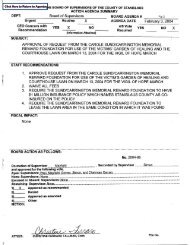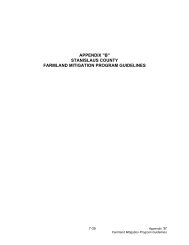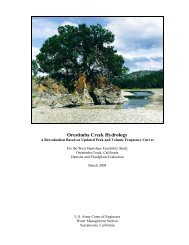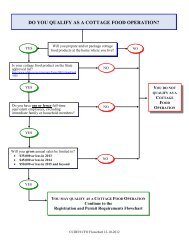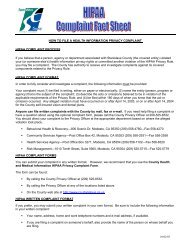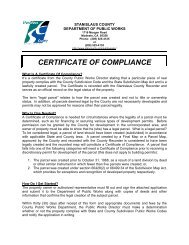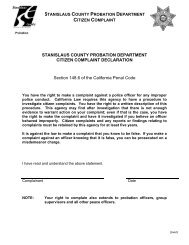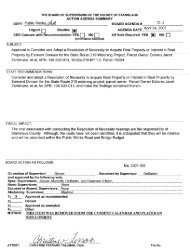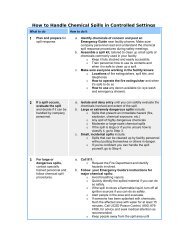Orestimba Creek Feasibility Study - Stanislaus County
Orestimba Creek Feasibility Study - Stanislaus County
Orestimba Creek Feasibility Study - Stanislaus County
Create successful ePaper yourself
Turn your PDF publications into a flip-book with our unique Google optimized e-Paper software.
Economics Appendix – Draft Report - <strong>Orestimba</strong> <strong>Creek</strong> <strong>Feasibility</strong> <strong>Study</strong>, <strong>Stanislaus</strong> <strong>County</strong>, California – September 2012<br />
restoration costs are based on estimates of cultural procedures from the University of California,<br />
Davis and range, for this type of flooding, from a cost of $0 to $208 for open and perennial<br />
planted cropland. The level of restoration requirement is consistent with the post-flood demands<br />
identified in other USACE studies.<br />
Table 2 – Per Acre Field Cropland Restoration Costs<br />
Operation<br />
$ Cost/per Acre<br />
Debris/Trash Removal 40.00<br />
Subsoil and Roll (2X) 44.00<br />
Chisel Field (2 times) 25.00<br />
Laser Level (25%) 44.00<br />
Triplane (2X) 22.00<br />
Repair/Replace<br />
Irrigation System<br />
33.00<br />
Total 208.00<br />
The average clean-up and restoration costs over the entire floodplain are estimated to be $96 per acre.<br />
However, based on the spreadsheet analysis using the Palisades @Risk software and a triangular<br />
distribution of low, high and median restoration costs the estimate is $115 per acre for this analysis.<br />
It is noted that the restoration costs include only those costs that re-establish the land to a condition<br />
prior to the incurrence of any of the expected annual production costs. Accordingly, restoration costs<br />
do not provide for fertilizing, applying herbicide, or any pre-planting activities that are expected to<br />
occur during the normal growing season.<br />
Pollutants<br />
In an article in the Los Angeles Times dated March 22, 2010 writer John Flesher discussed the<br />
possible environmental hazards associated with flooding in the Fargo North Dakota area. These<br />
impacts are similar to what could be expected in the Newman, California area and are related for<br />
informational purposes and, to the extent possible, are included in this economic analysis.<br />
Floodwaters can be noxious brews of pesticides, sewage, garbage and animal carcasses<br />
that foul drinking water, spread disease and damage fish habitat. Although the Red River<br />
didn't do nearly as much damage this year as during record-breaking floods in 2009,<br />
authorities say danger could persist.<br />
"Fuels, chemicals, all kinds of things find their way into the water system and it's a huge<br />
environmental risk," said Keith Berndt, engineer for Cass <strong>County</strong>, which includes Fargo<br />
and West Fargo.<br />
"We don't want people to use used sand for old sand bags in their kids' sand boxes or<br />
anywhere else they could come in direct contact with it," said Myron Bergland,<br />
environmental health manager for Fargo-Cass Public Health.<br />
56




